spk-all-4.htm
by U Kyaw Tun (UKT) (M.S., I.P.S.T., USA),
Daw Khin Wutyi, and staff of Tun
Institute of Learning (TIL).
from Learn Mon Yourself :
pronouncing all 61 lessons (Spk-all):
Downloaded and set in HTML by UKT and
staff of TIL . Not for sale. No
copyright. Free for everyone.
Prepared for students and staff of
TIL Computing and
Language Center, Yangon, MYANMAR :
http://www.tuninst.net ,
www.romabama.blogspot.com
index.htm |
Top
spk-all-indx.htm
SpkAll group #04
Mon-Myan medials and conjuncts
Lesson 29
Lesson 30
Lesson 31
Lesson 32
- UKT 130412, 150930, 160817:
Bur-Myan has monosyllabic medials -
![]() {ya.ping.},
{ya.ping.},
![]() {ra.ric}, &
{ra.ric}, &
![]() {ha.hto:}.
The
{ha.hto:}.
The
![]() {la.hswè:}
&
{la.hswè:}
&
![]() {wa.hswè:}
are not strictly monosyllabic: they generally sound disyllabic. They must be
considered to be conjuncts.
{wa.hswè:}
are not strictly monosyllabic: they generally sound disyllabic. They must be
considered to be conjuncts.
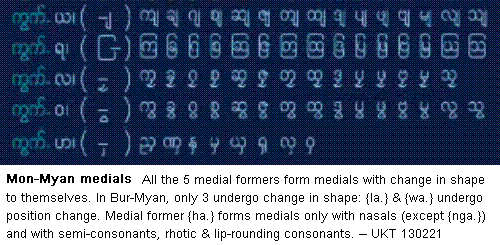
The following are common hanging-consonants
![]() of Mon-Myan,
of Mon-Myan,
![]() {na.hswè:},
{na.hswè:},
![]() {ma.hswè:},
{ma.hswè:},
![]() {la.hswè:},
&
{la.hswè:},
& ![]() {wa.hswè:}
{wa.hswè:}
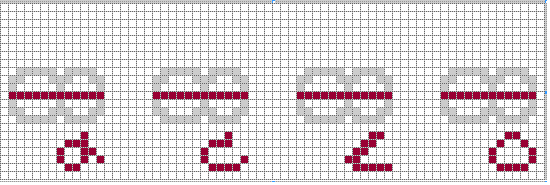 .
.
Caveat: Conjuncts given by Haswell do not agree
with Spk-all: see "compound consonants" p.6/pdf31,
- MonMyan-Haswell-gramm-notes-vocab<Ô>
/ bkp<Ô> (link chk
160809).
On the other hand, Naing Maung Toe gives 11
![]() consonants: see "hanging consonants" p047/pdf051.
consonants: see "hanging consonants" p047/pdf051.
-
MonMyan-NMgToe-Mon-Bur<Ô>
/ bkp<Ô>
(link chk 160809).
SN-SpkAll-les29-61<Ô> / bkp29<Ô> (link chk 160811), & lesson29-61<))
- UKT 130412, 150930, 160817:
In the table below, you will see 11 hanging-consonants of Mon-Myan which may be classed as conjuncts.
 -
lesson29-61txt<))
-
lesson29-61txt<))
The sounds are
arranged in 2 columns. Go vertical for both.
SN-SpkAll-les30-61<Ô> / bkp30<Ô> (link chk 160811), & lesson30-61<))
UKT 130413:
![]() {ga.}
{ga.}
![]() {käun}
{käun}
![]() {kmak} -
{kmak} -
![]() {na.} -
{na.} -
![]() {ga.mleing}
{ga.mleing}
{ga.mleing} - n. the many -- Has051
UKT 130423: Translating an unknown language by picking words from a dictionary can be fun. It was a game I used to play with as child while learning English. I came up with many phrases because of which I became the butt of many jokes. If you are getting bored learning Mon-Myan, try my game and ask a Mon-Myan speaker-writer to be the judge.
UKT 130413: The online lesson is very instructive. It reminds me of Bur-Myan
![]() {þing-poan:kri:} which I as a child had to learn while I was going to Gya-kyaung
{þing-poan:kri:} which I as a child had to learn while I was going to Gya-kyaung
![]() {kra:kyaung:} school in Kungyangon during the Second World War. The name of the
monastery means an 'in-between' monastery -- not
{kra:kyaung:} school in Kungyangon during the Second World War. The name of the
monastery means an 'in-between' monastery -- not
![]() {kya:}
'tiger'. The school was located in a monastery compound but was run by a
civilian head-master, U Po Hlaing, and his son U Nyunt Swé. It was then moved
outside the monastery compound. It was just 70 years ago -- but I am still
indebted to my early Burmese teachers. Unknown to most of us, and certainly not
to the colonialist educators that
{kya:}
'tiger'. The school was located in a monastery compound but was run by a
civilian head-master, U Po Hlaing, and his son U Nyunt Swé. It was then moved
outside the monastery compound. It was just 70 years ago -- but I am still
indebted to my early Burmese teachers. Unknown to most of us, and certainly not
to the colonialist educators that
![]() {þing-poan:kri:} is phonetic in nature, and if a Myanmar child knows it he has
phonetics at his command. Such methods had been used to teach phonetics for
thousands of years. The former colonialist educators and their faithful Myanmar
followers, such as U Pe Maung Tin, have done their best to uproot our cultural
heritage and we the modern-educated have been in league with them all the time.
Shame on me!
{þing-poan:kri:} is phonetic in nature, and if a Myanmar child knows it he has
phonetics at his command. Such methods had been used to teach phonetics for
thousands of years. The former colonialist educators and their faithful Myanmar
followers, such as U Pe Maung Tin, have done their best to uproot our cultural
heritage and we the modern-educated have been in league with them all the time.
Shame on me!
However, to be fair to the colonial-educators and their early Myanmar students, it must be pointed out that when they were reformulating the education systems in the British-Indian Empire (Myanmarpré was then just a province of India), the Western phonetics as a science was still in infancy, and early philologists had no instrument - not even a recording machine at hand, and they had to make do with just their hearing - which of course was severely limited because of their cultural heritage. They were foreign to tenuis sounds and nasals. Moreover most of them were under the impression that because the European powers had overwhelmed us, they had a poor view of our religion - even the scientific philosophy of Gautama Buddha!
UKT 130423: Notice that the above 11 conjuncts can be considered to be made up of
4 groups:
#1.
![]() {na.hswè:},
{na.hswè:},
![]() {ma.hswè:}
{ma.hswè:}
#2.
![]() {ya.ping.},
{ya.ping.},
![]() {ra.ric},
{ra.ric},
![]() {la.hswè:},
{la.hswè:},
![]() {wa.hswè:}
{wa.hswè:}
#3.
![]() {ngra.hswè:},
{ngra.hswè:},
![]() {Ña.hswè:},
{Ña.hswè:},
![]() {d³a.hswè:},
{d³a.hswè:},
![]() {b'a.hswè:}
{b'a.hswè:}
#4. ![]() {ha.hto:}
{ha.hto:}
If you are a Bur-Myan speaker-writer, you are already familiar with groups #2
and #4. It is interesting to note that Haswell does not include
![]() {Ña.hswè:} in his group of medials. See p006. He lists only 10 medials.
{Ña.hswè:} in his group of medials. See p006. He lists only 10 medials.
SN-SpkAll-les31-61<Ô> / bkp31<Ô> (link chk 160811), & lesson31-61<))
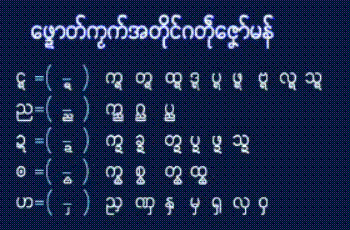
UKT 160817: As usual I have surfed the Net for more Mon language programs.
Below is from an Internet upload by "metta321"
captioned "Learn Mon Language part 2 of 2.wmv" . Listen to the sound by going
online:
-
https://www.youtube.com/watch?v=9x2ztOuM-uc 160817
The online sound, matches lesson31-61txt<))
The over an hour program is under the heading, and is the same as
lesson31-61<))
The uploader Metta321 states:
Uploaded on Aug 10, 2011 : Collection of "Learning Mon" set of 61 videos
downloadable from YouTube. Most of these videos explain just and only Mon
scripts and its reading. Mon Language is a language of an ethnic minority in
Southern Burma (Myanmar) in their "Mon State". This language is similar to Khmer
by pronunciation and grammar, similar to Myanmar language by script and similar
to both by vocabulary. First part of this video contains videos 1-30. Second
part contains videos 31-61.
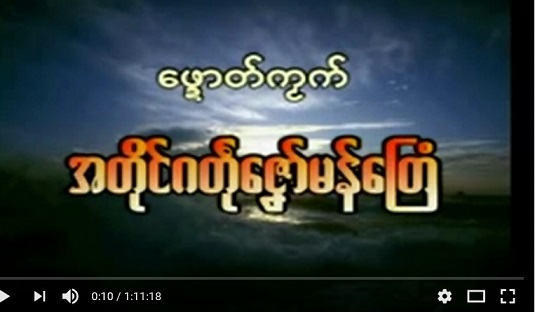
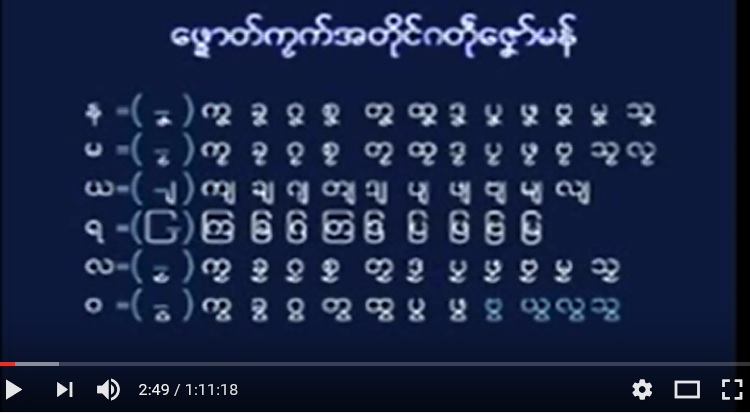
SN-SpkAll-les32-61<Ô> / bkp32<Ô> (link chk 160811), & lesson32-61<))
UKT 150930, 160818:
In Bur-Myan we have three registers: short
![]() {a.} (1 blk), long
{a.} (1 blk), long
![]() {a} (2 blk), emphatic
{a} (2 blk), emphatic
![]() {a:} (2 blk + emphasis).
Mon-Myan also has three, beginning with very-short
{a:} (2 blk + emphasis).
Mon-Myan also has three, beginning with very-short
![]() {a:.},
but without the emphatic of Bur-Myan. The Bur-Myan equivalent of Mon-Myan
{a:.},
but without the emphatic of Bur-Myan. The Bur-Myan equivalent of Mon-Myan
![]() {a:.} is
{a:.} is
![]() {aa.}.
Taking the two together, describing each by its vowel duration:
{aa.}.
Taking the two together, describing each by its vowel duration:
{a:.} (1/2 blk),
{a.} (1 blk), long
{a} (2 blk), emphatic
{a:} (2 blk + emphasis)
The sound of Mon-Myan
{a:.} (1/2 blk) is the same as Bur-Myan
{aa.}.
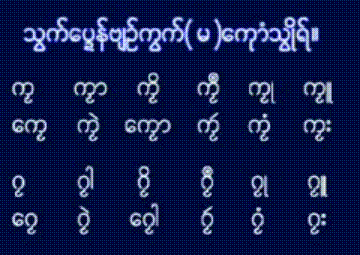
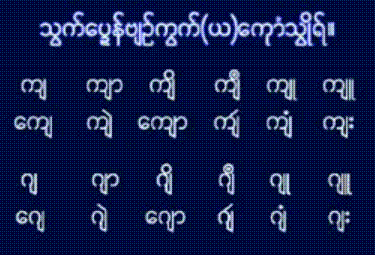
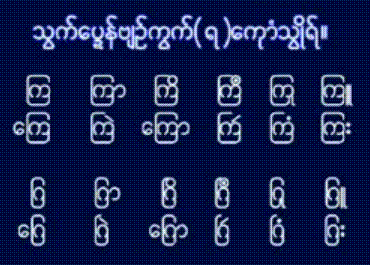
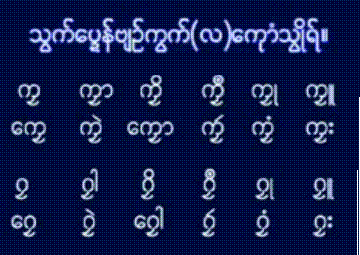
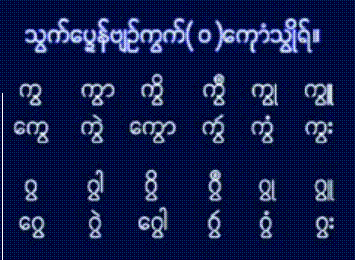
The following is the closing statement.
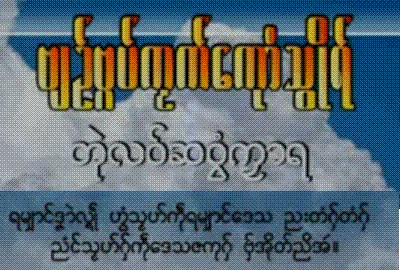
End TIL file